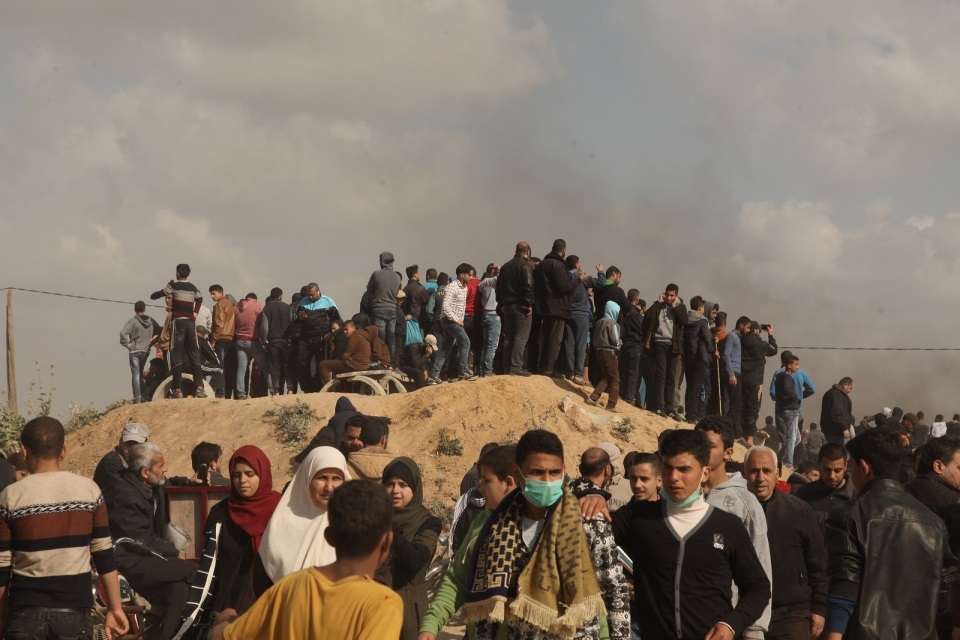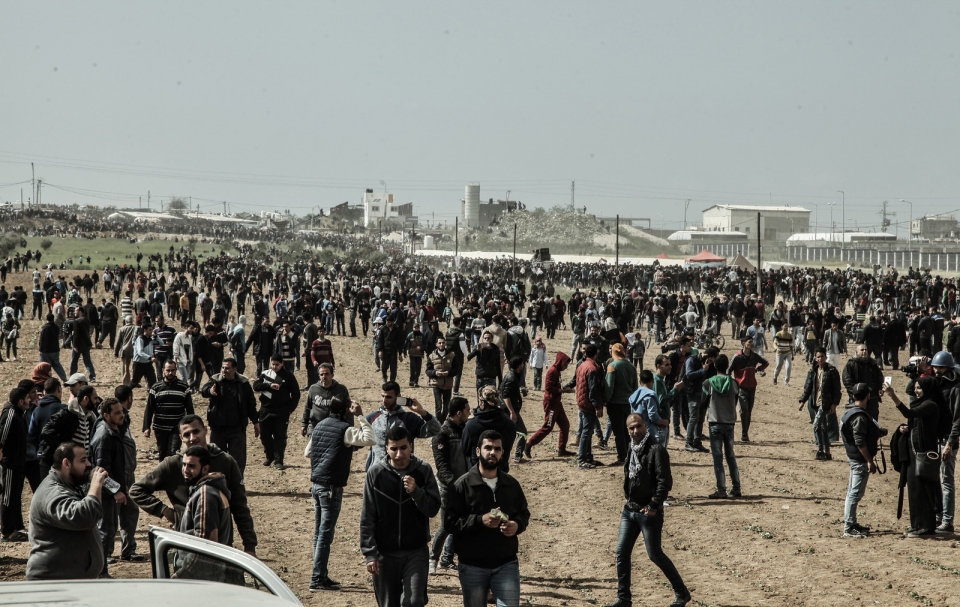
Note: Palestinians in Gaza have been protesting nonviolently weekly at the border fence adjacent to Israel since March 30th, 2018. Their demands are to end the brutal siege of Gaza and for the refugees to be able to return to their lands from which they were expelled in 1948. Two of every three people in Gaza are registered refugees. Gaza now has a population of over 2 million.The Israeli military has responded brutally to the protests, and has killed 217 Palestinians in Gaza and injured 22,897. Recently Israel has threatened war against Gaza to stop the protests. Ali Abdalbari, AFSC staff in Gaza, recounts his experience of the early days of the Great March of Return, what the protests are about and his experiences in the encampment. Learn more about Gaza and find out ways to work to end the blockade at Gaza Unlocked. Take action: Tell Congress to immediately oppose new attacks on Gaza.
The call for the Great March of Return is about the land and the connection with our history and our existence. When I went there I saw people who are very poor. These people understand exactly what the problem is and they are fighting for their rights because they understand that nobody else will defend them. These are just ordinary people in Gaza, they are creative, and they are implementing practices that make this demonstration effective. Most people who are responding to the call of the March of Return are not affiliated with Hamas or Fatah, people are there because they believe that the basic issue is the conflict between Palestinians and Israelis.
Their protest is not only reflected within the Gaza community, but it's mirrored in the West Bank, in 1948 Palestine (Palestinian citizens of Israel) and all over the world.
I attended the protest on the first day, it was a very peaceful demonstration. However, despite the peacefulness, the Israelis started shooting and throwing tear gas at the protestors. The youth then decided to bring car tires over to create a wall so that they could prevent the snipers from seeing them during the demonstration. The protestors started using kites, and making groups to protect one another. When the Israeli soldiers throw tear gas to attack the Palestinians, they are supporting each other in powerful ways. You can feel the sense of community. The Palestinians facing all these bad situations still believe in themselves, instead of running away, they are still struggling for their rights in very innovative ways.
These young people are visionary. These are people who have never once seen an Israeli with their own eyes. I took my brother to the demonstration, he's 13 years old and as soon as we reached the protest area, he saw the soldiers from about 400 meters away. He asks me, "Why are they occupying our lands?"
My brother has been afraid to sleep alone in his room because there are bombings. In his lifetime he has seen three long wars and so much bombing between the wars. He has never experienced 24 hours of electricity.
He has never had the chance to get out of Gaza. He has seen the world through Facebook and YouTube. It is amazing for these young people [to have the political imagination] to do what they are doing. The demonstrators have had the chance to see that they are affecting Israel. They are doing something to return to their lands, to their identity, and to their freedom.
To help you to imagine the place, there is a street called Western Street in Gaza. It skirts along the border, the eastern border with the land occupied in 1948. Before year 2000, the area between the border and this street was full of big trees, ancient trees. After the Second Intifada, Israel invaded this area. They demolished all the trees and everything is now on one level. There are no trees, no homes, no buildings, no nothing.
If you go to the camps of The Great March of Return you will be about 800 meters from the borders, the separation fence. People do activities there. Some people go there and do workshops about Palestine, about the Return. People tell the oral histories of their original villages.
There is a village in Gaza that has three people who are working as eye doctors. So these doctors say the will be in the tent at the Great March of Return site and are happy to make a free test for people who come there.
Some people are wearing Batman and Superman and Avatar costumes. I am sure you heard about Razan al-Najjar, the medic worker that was murdered by Israeli snipers. She was volunteering, providing medical support for people who were injured. A man asked her to marry him in the camp, they announced their engagement there. People are practicing life and liberation in the shadow of Israeli snipers.
There is a video of one of the young demonstrators. He was doing an interview with the media, and the Israelis shot him in his face while he’s talking to the media. Can you imagine? It’s very brutal. It’s very sad there and it’s amazing the courage of the people. People are being murdered just for practicing their vision of a liberated future.
Now we are talking about more than 22,000 people injured. We are talking about more than 210 people who have died from Israelis shooting them, including one baby, aged three month old. [These numbers are from an OCHA report from this week, when Ali wrote this in May initially, these numbers were much lower. - Editor]
I have a friend. We were activists working together at the university, working together in the movement. He is a very good person and he believed in the struggle of the community. When he went to the demonstration Israelis shot him and he became a martyr. We honor those who die while struggling for our freedom by calling them martyrs. It was very hard for me.
This is a demonstration of what it means to be Palestinian, to practice living in the face of oppression. It is living and caring for each other, proposals of marriage in the face of deep brutality, it’s just what it means to be Palestinian in Palestine. It’s a demonstration. We are going to choose to envision a world in which we all are free, even if there are consequences and to struggle for and to show the world what it would look like if we were free even though we know what the consequences might be.

Palestinians are under this oppression but are continuing to challenge Israel. I think that it’s a very strong message that after 70 years of being under occupation, after all this war and siege; Israel's continuous way of dehumanizing people, and after all this support from the U.S. and different countries for Israel we are still here struggling, and resisting our oppressors.
We are still fighting to go back home. We don’t want to depend on food support from the outside. We want a political solution to our situation. We need our dignity. We need our self-determination. Forcing people to starve does not take away their dignity. We still have our dignity.